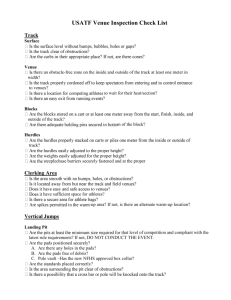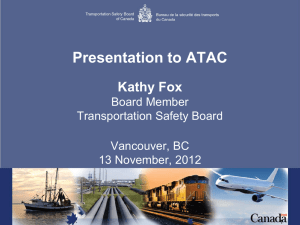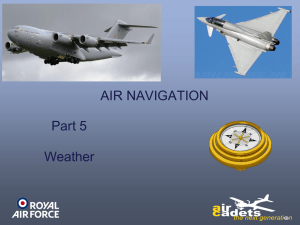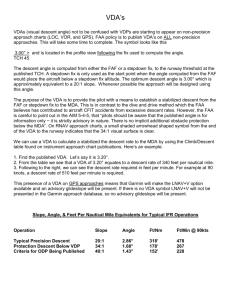IAPs - Leading Edge Flying Club
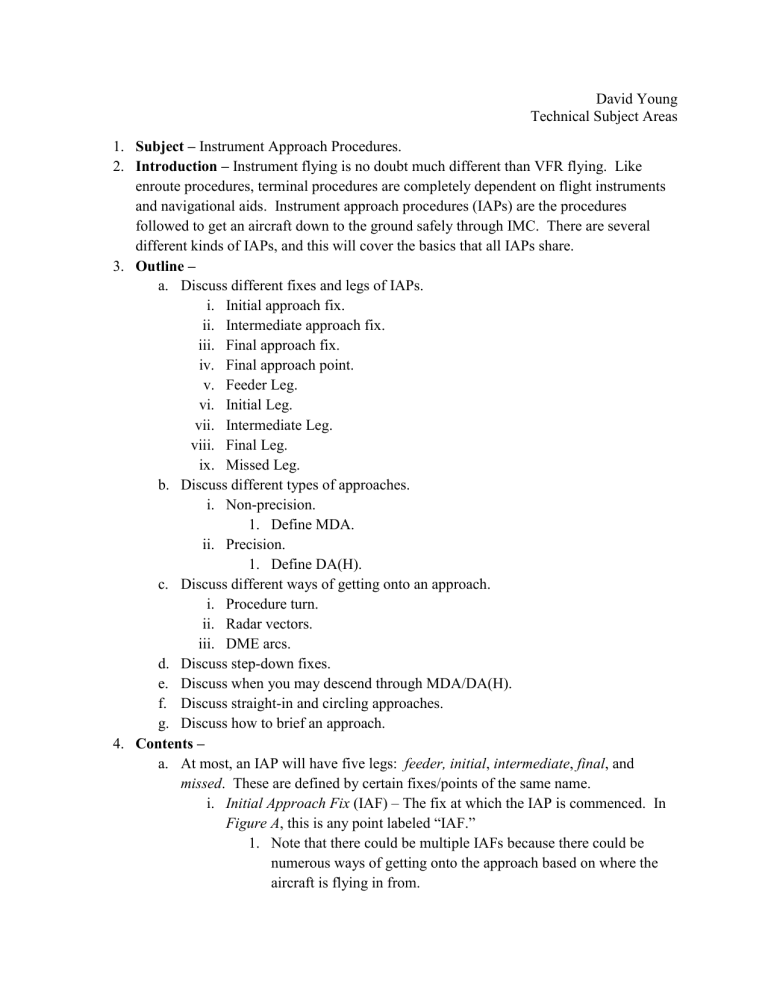
David Young
Technical Subject Areas
1.
Subject – Instrument Approach Procedures.
2.
Introduction – Instrument flying is no doubt much different than VFR flying. Like enroute procedures, terminal procedures are completely dependent on flight instruments and navigational aids. Instrument approach procedures (IAPs) are the procedures followed to get an aircraft down to the ground safely through IMC. There are several different kinds of IAPs, and this will cover the basics that all IAPs share.
3.
Outline – a.
Discuss different fixes and legs of IAPs. i.
Initial approach fix. ii.
Intermediate approach fix. iii.
Final approach fix. iv.
Final approach point. v.
Feeder Leg. vi.
Initial Leg. vii.
Intermediate Leg. viii.
Final Leg. ix.
Missed Leg. b.
Discuss different types of approaches. i.
Non-precision.
1.
Define MDA. ii.
Precision.
1.
Define DA(H). c.
Discuss different ways of getting onto an approach. i.
Procedure turn. ii.
Radar vectors. iii.
DME arcs. d.
Discuss step-down fixes. e.
Discuss when you may descend through MDA/DA(H). f.
Discuss straight-in and circling approaches. g.
Discuss how to brief an approach.
4.
Contents – a.
At most, an IAP will have five legs: feeder, initial , intermediate , final , and missed . These are defined by certain fixes/points of the same name. i.
Initial Approach Fix (IAF) – The fix at which the IAP is commenced. In
Figure A
, this is any point labeled “IAF.”
1.
Note that there could be multiple IAFs because there could be numerous ways of getting onto the approach based on where the aircraft is flying in from.
Young 2, IAPs ii.
Intermediate Approach Fix (IF) – This fix is used to navigate to the final approach fix from the initial approach fix.
1.
Note that not all approaches have IFs. Instead, usually more complicated ones (like Figure A ) contain them to help a pilot navigate to the final approach fix. iii.
Final Approach Fix (FAF) – The fix from which a descent is started to the lowest altitude published for the approach. In Figure A , this is the point labeled with a Maltese cross - .
1.
For non-precision approaches, a timer is usually started upon crossing the FAF to help the pilot know when he/she is at the
MAP.
2.
Note that not all approaches have a FAF (refer to Figure B ). a.
This is usually when the navigational aid used in the approach is located on the field. b.
When this is the instance, a distance, usually within 10 nm from the navaid, is used to determine when the aircraft can begin its descent. iv.
Final Approach Point (FAP) – The point at which the final approach course is intercepted inbound.
1.
This point exists regardless of whether or not the FAF exists. v.
Feeder Leg – The leg used to transition the aircraft from the enroute phase to the IAF, from which the IAP can be executed. vi.
Initial Approach Leg
– The leg began by the IAF and terminated by the IF
(if one exists), FAP, or the FAF. vii.
Intermediate Approach Leg – The leg began by the IF and terminated by either the FAP or the FAF. viii.
Final Approach Leg – The leg began by either the FAP or the FAF and terminated by the missed approach point (MAP) or landing.
1.
Missed Approach Point (MAP) – The point at which the approach must be broken off if certain requirements are not met (this will be discussed shortly). ix.
Missed Approach Leg – The leg began by the MAP on which the aircraft will transition from an approach phase to an enroute phase.
1.
This leg is usually depicted as a segmented line with an arrow at the tip - . b.
There are two different categories of approaches: non-precision and precision approaches. i.
Non-Precision Approach – An approach that contains no electronic glideslope information.
Young 3, IAPs
1.
This means that lateral navigation is given (meaning whether you are right or left of course), but no vertical guidance is given
(meaning whether you are high or low).
2.
Minimum Descent Altitude (MDA) – The lowest altitude you can descend to on a non-precision approach. a.
You must maintain this altitude until the runway environment is in sight (we will discuss specifics later) or you have reached the MAP and the airport is not in sight. b.
MDA will usually get you down to about 300 – 400 ft HAA
(Height Above Airport). c.
The MAP is defined by either a time based on the groundspeed from the FAF or, if the navaid is on the field, station passage. d.
On a non-precision approach, once you have reached the
MAP at MDA, you must go missed if the requisite criteria have not been met.
3.
Visual Descent Point (VDP) – The point at which a normal 3° approach path can be started down to the runway. a.
Descent before the VDP is NOT ADVISABLE before the
MDA.
4.
VOR , GPS/RNAV , NDB , Localizer (LOC), Localizer Backcourse
(LOC BC), Airport Surveillance Radar (ASR), Localizer-type
Directional Aid (LDA), and Simplified Directional Facility (SDF) approaches are all examples of non-precision approaches. ii.
Precision Approach – An approach that contains some sort of electronic glideslope information.
1.
Decision Altitude (Height) (DA(H)) – The altitude at which you must go missed if the requisite criteria have not been meet. a.
The MAP is defined as the point that you reach DA. i.
This means that when you descend to DA, you have hit your MAP.
2.
Your glideslope information is usually displayed on an OBS or
HSI as a horizontal bar.
3.
Instrument Landing System (ILS), Microwave Landing System
(MLS), Precision Approach Radar (PAR), and GPS with WAAS
(Wide-Area Augmentation System) are all examples of precision approaches. iii.
The MDA/DA is defined for different category of aircraft based on their maneuvering speeds at maximum gross weight (1.3 * V s
):
1.
A: 0 – 90 kts.
Young 4, IAPs
2.
B: 91 – 120 kts.
3.
C: 121 – 140 kts.
4.
D: 141 – 165 kts.
5.
E: Above 165 kts. c.
There are three different ways of getting onto an approach: course reversals , radar vectors , and DME arcs . i.
Course Reversal – any point after the IAF where the course is reversed to get onto the final approach course (FAC).
1.
IAPs with some form of course reversal are usually called “full approaches.”
2.
One way of doing this is a procedure turn, which is a turn off of the approach course outbound to re-intercept the final approach course inbound (refer to Figure C ). a.
In this example, you are to fly a HEADING of 187° for
ONE MINUTE, then begin a standard rate turn to 007° and fly that heading until you re-intercept the FAC inbound. i.
The outbound procedure turn leg should always be for one minute in light GA aircraft. b.
According to Figure D
, once you are on the 232° radial outbound (you have overflown the CMI VORTAC), you may begin your descent down to 2,300 ft. You must stay at or above this altitude until you are procedure turn inbound, which means you are re-intercepting the FAC inbound, at which point you may begin your descent down to MDA
(1,140 ft). c.
The “Remain within 10 nm” message means that if you adhere to the given altitudes within 10 nm from CMI
VORTAC, then you will be guaranteed standard obstacle clearance.
3.
Another way of doing this is a holding pattern, which can be used to reverse your course (refer to Figure E ). a.
In this example, you are to fly to USAVY, then execute a hold to get procedure turn inbound (179° TO). ii.
Radar vectors can be used to sequence an aircraft to the FAF.
1.
In this case, no course reversal is necessary. Instead, ATC will vector the aircraft all the way to the FAF through a series of turn and descent instructions. iii.
DME Arcs – A circular shape flown with a certain DME radius from a
VOR.
1.
These arcs are flown until the FAC is intercepted inbound.
Young 5, IAPs
2.
No course reversals are necessary for these. d.
Some approaches do not have a smooth descent from the FAF to the MDA/DA.
Instead, they sometimes have stepdown fixes . i.
Stepdown Fix – A fix at which the aircraft is not allowed to descend below a specified altitude until that fix is passed.
1.
These are used mainly for obstacle clearance purposes. e.
Although a pilot may SHOOT an approach whenever he/she wants, he/she can only land out of the approach if certain minimums are met (91.175): i.
The aircraft is continuously in a position from which a descent to a landing on the intended runway can be made at a normal rate of descent using normal maneuvers, and for operations conducted under part 121 or part 135 unless that descent rate will allow touchdown to occur within the touchdown zone of the runway of intended landing; ii.
The flight visibility is not less than the visibility prescribed in the standard instrument approach being used; and iii.
Except for a Category II or Category III approach where any necessary visual reference requirements are specified by the Administrator, at least one of the following visual references for the intended runway is distinctly visible and identifiable to the pilot:
1.
The approach light system, except that the pilot may not descend below 100 feet above the touchdown zone elevation using the approach lights as a reference unless the red terminating bars or the red side row bars are also distinctly visible and identifiable.
2.
The threshold.
3.
The threshold markings.
4.
The threshold lights.
5.
The runway end identifier lights.
6.
The visual approach slope indicator.
7.
The touchdown zone or touchdown zone markings.
8.
The touchdown zone lights.
9.
The runway or runway markings.
10.
The runway lights. f.
There are two sub-categories of approaches: straight-in or circling . i.
Straight-In – When the FAC is within 30° of the runway and a normal descent-to-landing can be made.
1.
These types of approaches are labeled with the runway e.g. VOR-
22. ii.
Circling – When the FAC is more than 30° off the runway or a normal descent-to-landing cannot be made.
Young 6, IAPs
1.
These types of approaches are labeled with a letter rather than a runway number e.g. VOR-A.
2.
Circling approaches may also be used if a pilot wishes to shoot an approach to one runway, but land on another (possibly because the winds favor the other runway).
3.
In this case, straight-in minimums cannot be used, but circling minimums can.
4.
When circling, the pilot must maintain a specified radius (in miles) from the airport based on his/her aircraft’s category: a.
A: 1.3. b.
B: 1.5. c.
C: 1.7. d.
D: 2.3. e.
E: 4.5. g.
Shooting an approach requires you to be able to read the approach plate. Now that we have a good understanding of IAPs, let us review how to “brief” or read and prepare for an approach. i.
Although there are many different ways of briefing an approach, I like the
“WIRE” briefing.
1.
W – Weather (get it)
2.
I – Instruments (align DG, check altimeter)
3.
R – Radios/Radials (maximize the usage of comms/navs).
4.
E – Everything else (MDA/DA, time to MDA/DA, the initial step of the missed approach, and any notes). ii.
Each plate is broken up into the header , notes , frequencies , plan , profile , airport plan , and minimums sections.
1.
Header – Contains the type of approach, the airport the approach is at, and pertinent altitude information for the airport.
2.
Notes – Some IAPs have special notes because they have abnormal procedures. Check them.
3.
Frequencies – Comm and nav frequencies that are listed in the order you will use them.
4.
Plan – An overhead view of the approach to give you an idea of what it looks like from a bird’s-eye view.
5.
Profile – A side-shot of the IAP to help you get an idea of what the
IAP looks like vertically.
6.
Airport Plan – A plan view of the airport as well as pertinent runway information (lighting, length, etc…).
7.
Minimums – A list of all the minimums for the approach for the different categories of aircraft.
Young 7, IAPs iii.
As far as reading the approach plate (slang term for a depiction of an
IAP), I find it best to read the top line right-to-left, and then progress through the rest of the sections of the plate from left to right.
1.
This ensures all the information is covered adequately.
5.
Evaluation – a.
The student can list the different fixes and legs of an approach. b.
The student can explain the differences between non-precision and precision approaches as well as terms associate with the two. c.
The student can explain different ways of getting onto an approach. d.
The student can define a stepdown fix. e.
The student can explain when he/she can descend below MDA/DA. f.
The student can explain what a straight-in and a circling approach is. g.
The student can brief an approach.
6.
References
– a.
FAR 91.175.
NOT INTENDED FOR NAVIGATION PURPOSES
Young 8, IAPs
NOT INTENDED FOR NAVIGATION PURPOSES
Figure A
NOT INTENDED FOR NAVIGATION PURPOSES
Young 9, IAPs
NOT INTENDED FOR NAVIGATION PURPOSES
Figure B
Young 10, IAPs
Figure C
Figure D
Figure E

